
Wine Culture and Information since 2002 - Volume 22
 Wine Culture and Information since 2002 - Volume 22 |
|
Issue 234, December 2023 |
Contents |
|
|
Harvest 2023: First Assessments and Impressions |
|
The forecasts for the 2023 vintage, disclosed well in advance of the actual start of the harvest, were certainly not among the most exciting ones in recent years. From north to south, the forecasts for Italy painted a scenario in which – in general terms – it would have been very likely, with a quite depressed and sad heart, to bring to the winery a harvest that was decidedly lower than in previous years, at least from a quantitative point of view. In fact, one of the poorest harvests in recent decades was expected for the 2023 harvest, with very few regions recording a positive and growing trend compared to 2022. The grape harvesting operations are now completed, and the must is on its way since some time on the path that will transform it into wine, we can therefore verify the situation of the 2023 harvest, as well as draw the first conclusions regarding those forecasts. From what emerges according to first impressions, it would seem that not everything should be considered negatively, even tough, in general terms, those predictions have been confirmed. The forecasts released before the harvest – you will certainly remember that – were largely formulated based on the meteorological trend as well as the occurrence of parasites and diseases which affected the vineyards of Italy. It is a widespread opinion everywhere in the country that the quantity of grapes harvested in the vineyards is decidedly lower than in past years, however – in general terms – it is believed that the quality is instead high enough to promise wines of excellence. In short, not so much, however good. It must be said, in fact, that in addition to the meteorological trend, mainly characterized by a lack of rainfall, there were also the effects of downy mildew, which is notoriously not so kind to the vine. In some regions, the effect of the lack of rain was partly mitigated by the rainfall at the end of August and September, providing the land and the vines with fundamental water support such as to limit the effects of the drought and precisely at the moment during which the grapes proceed towards ripeness. Although the effect of the late summer rain was extremely important for the balance of the 2023 vintage, it obviously did nothing for the recovery of the bunches lost due to weather conditions and downy mildew. Italy – of course – was not the only wine-growing country in the world to record a loss in the production of grapes, and therefore of wine. In fact, in the main wine-growing countries of the world, a significant drop in the production of wine has been recorded in vineyards, most of the cases because of unfavorable weather conditions, recognizing as the main cause the climate change which is occurring almost everywhere in the world. For example, Argentina, Brazil, Chile and South Africa suffered losses from 10 to 30% compared to 2022. The United States of America is clearly going against the trend, where wine production of 25.2 million hectoliters is expected, corresponding to an increase of 12% compared to the past year. Even in Europe, as widely anticipated, the drops amounted to -6% which led to the production of a little over 150 million hectoliters of wine. Among the countries of the old continent, Italy has recorded a rather significant drop such as to cause it to lose its leading role in wine production. After seven years, therefore, Italy is no longer the main wine producer in Europe, leaving the highest rank of the podium to France. In Italy, in fact, the estimated production stands at 43.9 million hectoliters – with a decrease of 12% compared to 2022 – while France stands out with 45 million hectoliters, equal to an increase of 1.5% compared to the past year. Things did not go well even for the third European producer, Spain, which recorded a drop of 14%, while Germany lost 2% compared to 2022, with an estimated production of 8.9 million hectoliters of wine. In all cases, the main cause of these results was the meteorological trend, which was decidedly unfavorable for the cultivation of vines. Even in other European countries the situation was not favorable, with Austria recording a loss of 6% compared to 2022, Greece -23%, Croatia -31% and Slovakia -20%. The only country going against the trend is Portugal, which managed to increase production by 9%, corresponding to a little less than 10 million hectolitres. There is one point on which all wine-growing countries seem to agree and which will represent an increasingly important challenge for the future: climate change. Not least, the need to encourage the cultivation of varieties more resistant to the main vine diseases, as well as those more resistant to climatic conditions which seem to change almost everywhere. As an example, it can certainly be cited that – for some years now – the vine is being successfully cultivated in the south of the United Kingdom, so much so that an interesting wine production has started. A condition – this – which until a few decades ago seemed rather unlikely, if not impossible. Specifically, as regards the situation in Italy, in addition to the news relating to the 2023 harvest, the ICQRF (the Italian department of the central inspectorate for the safeguarding of quality and repression of fraud in agri-food products) has released the new report “Cantina Italia”, relating to the country's wine stocks. In particular, the quantity of wine still stored in Italian wineries – therefore, not yet sold – which will have to be added to that of the 2023 harvest. According to the ICQRF report, as of 31 October 2023, in Italian wineries there are still 43.2 million hectoliters of wine in stock, equivalent to -5.8% compared to the same period in 2022, however an increase of 2.5% compared to September. In detail, as of 31 October 2023, in the Italian wine factories are stored 43.8 million hectoliters of wine, 13.5 million hectoliters of must and 12.1 million hectoliters of new wine still in fermentation. 59% of the wine is stored in the wineries of the North, mainly in Veneto, where 24.5% of the national wine is present, especially in the provinces of Treviso (10.4%) and Verona (8.4%). 53.7% is classified as DOP (Denominazione d'Origine Protetta, Denomination of Protected Origin), 24.6% IGP (Indicazione Geografica Protetta, Protected Geographical Indication) and varietal wines represent just 1.6% of the total. As regards DOP wines, 52.2% is represented by red wines, which also constitute 61.7% of IGP wines. Finally, 18.4% is represented by other wines, while varietals make just 1.6% of the total. To these stocks will also be added the musts and wines produced from the 2023 harvest and not yet included in the ICQRF report which, it must be said, is based on the data contained in the electronic wine register and which, according to estimates, contains at least 95% of wine and must stored in Italy. To summarize things up, the data from the “Cantina Italia” report highlight that in the Italian wineries is currently stored a quantity of wine equal to that on average produced in a single harvest. It must be said – for clarity – that a large part of this wine is stored in the wineries waiting for the end of its aging period. But it is nevertheless clear that it is also wine from previous harvests and still unsold, which, with the arrival of the new wines from the 2023 harvest, will be rather unlikely to reach the market and therefore generate a profit. I am referring, in particular, to the so-called “ready-to-drink wine”, the one which generally has a commercial life of just under a year and which no one is looking for anymore with the arrival of the new vintage wines. If it is true that Italian wine is experiencing good sales success, especially with exports, it is also true that it is not so easy to sell such a large quantity of wine in the relatively short time of a year. Because it is clear that – in 12 months – we will make exactly the same considerations for the wine of 2023 vintage while thinking about the future of that of 2024. In the end, well aware of being decidedly “unpopular”, the decline in production of the 2023 vintage could also be useful to improve the critical condition of inventories and bring back some balance and awareness. Antonello Biancalana
|
||||
Contrasts of Bardolino Classico Chiaretto and Salice Salentino RosatoThis month we color our glasses pink by comparing two distant and different wines, expressions of two distant regions that only have style and color in common. |
|
Rosé wines are living, so to speak, a second youth. For some years – and this is a decidedly positive fact – wine enthusiasts have rediscovered, or perhaps discovered for the first time, the pleasure of seeing their glass colored pink. This has happened also thanks to the activity of the consortia of the denominations that provide for the production of rosé wines, with the full support of the producers who – for their part – have understood the importance of quality in the success of this style of wine. It should in fact be noted that, in times not too distant, rosé wines were often considered second line wines, placed on a lower level than the production of red and white wines. In the past, in fact, rosé wines were often the result of the “bleeding” of red wines, that is, a portion of “rosé must” was taken from the red wine fermentation tanks with the aim of obtaining a greater concentration of color and polyphenols. This practice is still in use today, of course, but it is evident that the quality and dignity of rosé wines has increased significantly in recent years. Today, at last, the majority of rosé wines are the result of a specific production practice that was expressly created and developed with the sole result of obtaining a rosé wine and not the by-product of another wine production. It should be noted, in fact, rosé wine is produced with a specific and particular technique, which involves a short maceration of the must from red grapes with their own skins. At the end of this phase – which generally ends in less than ten hours, rarely more than twelve and depending on the type of grape – the skins are separated from the must and the wine making proceeds until the final product is obtained, that is, a rosé wine. This month's tasting by contrast compares two famous wines belonging to this category and defined in specific production disciplinary: Bardolino Classico Chiaretto and Salice Salentino Rosato.
|
|
Bardolino is certainly one of the most famous and important denominations in the province of Verona, Italy. The production of this territory – which extends on the right bank of Lake Garda up to the municipalities on the outskirts of Verona – besides providing red wines, including the “Superiore”, recognized as a Denominazione d'Origine Controllata e Garantita (Denomination of Controlled and Guaranteed Origin, DOCG), it also produces a particular rosé wine, known as Chiaretto (Italian for “claret”). The name, decidedly evocative, underlines the typically “pale” color compared to the red of the area, as pale as deserving the name “Chiaretto”. The composition of the grapes is exactly the same provided for the red wines of Bardolino denomination and, among these, Corvina represents the main share. This variety, in fact, must be present for at least 35% and up to a maximum of 95%, admitting a maximum presence of 20% of Corvinone replacing Corvina. The complementary part is made up of Rondinella, for a minimum of 5% up to a maximum of 40%, possibly other red grapes allowed for cultivation in the province of Verona and for a maximum of 20%. These varieties also include Molinara, a typical and historic grape of the area, which can be present for a maximum of 15%. As regards the “Classico” designation – to which the wine we will pour into our glass belongs – it is only permitted for wines of the denomination produced in the municipalities of Bardolino, Garda, Lazise, Affi, Costermano and Cavaion. According to tradition, Chiaretto was produced in 1896 on Lake Garda by the Venetian senator, lawyer and writer Pompeo Molmenti. At that time he was in the village of Moniga del Garda and, by using the “white” winemaking technique learned in France with the typical red grapes of the area, he gave life to the “Chiaretto”. The success of the new wine was such that, in 1970, the wine journalist Zeffiro Bocci, in one of his articles summarizing the history of Venetian wines, stated that «in the Veronese wine-growing areas adjacent to Benaco (alternative name of Lake Garda), a well-defined Chiaretto del Garda has always been produced».
|
||||
|
Apulia and Salento have a deep connection with rosé wines, probably like no other Italian region or territory. Here, in fact, except for few cases, the denominations providing for the production of wines with red berried grapes also include that of rosés with the same varieties. The Denominazione d'Origine Controllata Salice Salentino (Denomination of Controlled Origin, DOC) of course, is no exception. The rosé style – in fact – represents the foundation of the entire denomination and is the style of wine that contributed most to the reconstitution and success of the viticulture of Salento, and therefore of Apulia, at the end of the Second World War. Salento's connection with wine, however, has decidedly more ancient roots and it is believed that the vine was present in these lands as early as 2000 BC. A bond so ancient that it has even influenced the local dialect, so much so that here the wine is called mjiere, mjier or mieru, clearly derived from the Latin merus, that is `pure”, “frank”. In this regard, it must also be said that in past times – specifically, those of ancient Rome – merum became synonymous with vinum – that is, wine – and was used when it was not mixed with other substances or water, therefore “pure”. The queen grape of Salento, also of its rosé wine, is Negroamaro which – according to the production disciplinary – must be present for at least 75%, while the remaining part can be made up of red berried grapes allowed for cultivation in Apulia region. In this regard, it should be noted that, in the majority of cases, this part is made of Malvasia Nera, a composition that mainly reflects the historical tradition of blending these two grapes for the production of local red and rosé wines. Salice Salentino Rosato usually expresses qualities of immediacy and crispness, often vinified in inert containers with the purpose of further enhancing the fruity character of Negroamaro and, not least, of Malvasia Nera.
|
Let's start this month's tasting by contrast and, before pouring the two wines into the glasses, let's find the bottles to be examined. Bardolino Classico Chiaretto and Salice Salentino Rosato are wines which are not so difficult to get, as they are quite widespread and can be easily purchased in any well-stocked wine shop. The production disciplinary of both wines allow the use of multiple varieties, therefore we will pay attention to their composition. As for Bardolino Classico Chiaretto, we will choose a bottle produced with Corvina, Rondinella and Molinara. The choice of Salice Salentino Rosato is determined by, so to speak, traditional and historical factors, therefore we will choose a bottle produced exclusively with Nergoamaro and Malvasia Nera. Both wines belong to the most recent harvest and will be served in tasting glasses at a temperature of 12 °C. (54 °F) After having poured Bardolino Classico Chiaretto and Salice Salentino Rosato into their respective tasting glasses, we can begin the organoleptic evaluation of the two wines, starting with the analysis of their appearance, that is, how they present themselves to the eye in terms of color and transparency. The first wine we examine is Bardolino Classico Chiaretto therefore, by tilting the glass over a white surface, we observe the base in order to evaluate the color and transparency. The Venetian wine presents itself to the eye with a light cherry pink color and good transparency, confirmed by the vision of the object placed in contrast between the glass and the white surface. Let's now observe the nuance of Bardolino Classico Chiaretto – towards the opening of the glass, where the thickness of the wine becomes thin – which confirms the light cherry pink base tone. Let's now pass on to evaluating the color of Salice Salentino Rosato and, by tilting the glass over the white surface, let's observe the base. In the Apulian wine we see an intense cherry pink color and generally darker than Bardolino Classico Chiaretto, however showing good transparency. The nuances of the wine is also intense cherry pink. The olfactory profiles of Bardolino Classico Chiaretto and Salice Salentino Rosato express very distinct characteristics on the nose, mainly due to the composition of the grapes and the respective territories. In Bardolino Classico Chiaretto – result of the blending of Corvina, Rondinella and Molinara – we can mainly perceive aromas of red pulp fruits, including raspberry, cherry and strawberry, as well as sensations of citrus fruits, mainly represented by tangerine and citron. The world of flowers of Bardolino Classico Chiaretto is generally expressed in the aromas of cyclamen and dog rose. In the olfactory profile of Salice Salentino Rosato mainly dominate the aromas of cherry, strawberry and blueberry, as well as raspberry, plum, peach and pomegranate. Furthermore, in the Apulian rosé wine, can also be clearly perceived aromas recalling flowers, in particular cyclamen, rose and hawthorn. Finally, Salice Salentino Rosato can sometimes express a pleasing hint of anise on the nose. Let's continue the tasting of the two wines of this month and proceed with the analysis of the olfactory profile of Bardolino Classico Chiaretto. Let's hold the glass in vertical position and, without swirling, do the first smell in order to appreciate the opening of the wine, that is, its primary and identifying aromas. On the nose we can perceive – intense and clean – aromas of raspberry, cherry and strawberry, followed by floral sensations reminiscent of dog rose and cyclamen. After having swirled the glass – an operation favoring the development of the other aromas – the olfactory profile of the Venetian rosé wine is completed with tangerine and citron, as well as blackberry and peach. Let's now move on to the evaluation of the olfactory profile of Salice Salentino Rosato and – by holding the glass in vertical position and without swirling – let's proceed with the evaluation of its opening. From the glass we can perceive intense and clean aromas of cherry, strawberry and blueberry, as well as floral aromas reminiscent of cyclamen and rose. After having swirled the glass, the profile of the Apulian wine is completed with aromas of blackberry, plum, pomegranate and peach. Let's now move on to the evaluation of the gustatory profiles of the two wines of our tasting by contrast, starting – as in the previous phases – from the examination of Bardolino Classico Chiaretto. Let's take the first sip of the Venetian wine, an operation allowing us to evaluate the attack, that is, the primary and identifying gustatory sensations. In the mouth we perceive a pleasing and intense crispness given by the acidity, a sensation which promptly finds balance thanks to the effect of the alcohol. The wine has a good body and in the mouth we can perceive flavors of raspberry, cherry and strawberry. Let's move on to the evaluation of the gustatory profile of Salice Salentino Rosato and then proceed with the analysis of its attack. After the first sip, the Apulian rosé wine expresses a marked crispness in the mouth given by the acidity – generally rounder than Bardolino Classico Chiaretto – also in this case balanced by the effect of the alcohol. In the mouth can be perceived, in addition to the good structure, flavors of cherry, strawberry, blueberry and blackberry. The final phase of the tasting focuses on the evaluation of taste-olfactory persistence, that is the measurement of the time during which it is possible to perceive the gustatory and aromatic qualities of the wine in the mouth after swallowing. The finish of Bardolino Classico Chiaretto is of good persistence and in the mouth we can continue to clearly perceive the flavors of raspberry, cherry and strawberry, as well as the pleasing sensation of crispness. The finish of Salice Salentino Rosato is equally persistent and, after swallowing, it is possible to continue perceiving the pleasing crispness and sensation of good body, generally more robust than Bardolino Classico Chiaretto. Furthermore, in the mouth are also clearly perceived the flavors of cherry, strawberry, blueberry and blackberry. Before concluding this month's tasting by contrast, let's evaluate the olfactory profiles of the two wines again. With the glasses side to side, let's proceed by smelling Bardolino Classico Chiaretto and then Salice Salentino Rosato. Despite the profiles are characterized mainly by red pulp fruits, the two wines evidently express unique and distinct characters.
|
||||||||
Wines of the Month |
|
|
|
Score legend Prices are to be considered as indicative. Prices may vary according to the country or the shop where wines are bought |
|
|
|
Colli di Parma Malvasia Spumante Extra Dry Acuto 2021 |
|
| Carra di Casatico (Emilia-Romagna, Italy) | |
 Malvasia di Candia Aromatica Malvasia di Candia Aromatica | |
| Price: € 9.40 | Score: |
 Brilliant straw yellow and nuances of straw yellow, very transparent,
fine and persistent perlage. Brilliant straw yellow and nuances of straw yellow, very transparent,
fine and persistent perlage.
 Intense, clean, pleasing and refined, starts with hints of apple, pear
and peach followed by aromas of broom, hawthorn, jasmine, pineapple,
tangerine, plum and acacia honey. Intense, clean, pleasing and refined, starts with hints of apple, pear
and peach followed by aromas of broom, hawthorn, jasmine, pineapple,
tangerine, plum and acacia honey.
 Effervescent and crisp attack, however balanced by alcohol, good body,
intense flavors, pleasing sweet hint. Effervescent and crisp attack, however balanced by alcohol, good body,
intense flavors, pleasing sweet hint.
 Persistent finish with flavors of apple, pear and peach. Persistent finish with flavors of apple, pear and peach. Produced with the Charmat method and aged on its lees for at least 6
months. Produced with the Charmat method and aged on its lees for at least 6
months.
|
|
 Pasta and risotto with fish and crustaceans, Stewed crustaceans, Mushroom soups, Vegetable flans Pasta and risotto with fish and crustaceans, Stewed crustaceans, Mushroom soups, Vegetable flans |
|
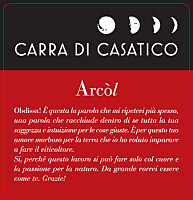
|
|
Arcòl 2017 |
|
| Carra di Casatico (Emilia-Romagna, Italy) | |
 Croatina (50%), Merlot (30%), Pinot Nero (20%) Croatina (50%), Merlot (30%), Pinot Nero (20%) | |
| Price: € 12.80 | Score: |
 Deep ruby red and nuances of garnet red, little transparency. Deep ruby red and nuances of garnet red, little transparency. Intense, clean, pleasing and refined, starts with hints of black
cherry, plum and black currant followed by aromas of dried violet,
blueberry, cocoa, tobacco, leather, mace, vanilla and eucalyptus. Intense, clean, pleasing and refined, starts with hints of black
cherry, plum and black currant followed by aromas of dried violet,
blueberry, cocoa, tobacco, leather, mace, vanilla and eucalyptus.
 Properly tannic attack and however balanced by alcohol, good body,
intense flavors, agreeable. Properly tannic attack and however balanced by alcohol, good body,
intense flavors, agreeable.
 Persistent finish with flavors of black cherry, plum and black currant. Persistent finish with flavors of black cherry, plum and black currant. 12 months in barrique, 4 months in bottle. 12 months in barrique, 4 months in bottle. |
|
 Broiled meat and barbecue, Stewed meat with mushrooms, Roasted meat, Cheese Broiled meat and barbecue, Stewed meat with mushrooms, Roasted meat, Cheese |
|
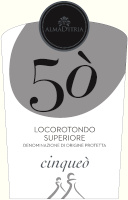
|
|
Locorotondo Superiore Cinqueò Almaditria 2021 |
|
| Upal (Apulia, Italy) | |
 Verdeca, Bianco d'Alessano, Minutolo Verdeca, Bianco d'Alessano, Minutolo | |
| Price: € 11.00 | Score: |
 Brilliant golden yellow and nuances of golden yellow, very transparent. Brilliant golden yellow and nuances of golden yellow, very transparent. Intense, clean, pleasing and refined, starts with hints of apple, pear
and broom followed by aromas of hawthorn, jasmine, medlar, citrus fruits,
pineapple, plum and peach. Intense, clean, pleasing and refined, starts with hints of apple, pear
and broom followed by aromas of hawthorn, jasmine, medlar, citrus fruits,
pineapple, plum and peach.
 Crisp attack and however balanced by alcohol, good body, intense
flavors, pleasing roundness. Crisp attack and however balanced by alcohol, good body, intense
flavors, pleasing roundness.
 Persistent finish with flavors of apple, pear and medlar. Persistent finish with flavors of apple, pear and medlar. Aged in steel tanks. Aged in steel tanks. |
|
 Pasta with fish, Sauteed white meat, Sauteed fish, Stewed fish with mushrooms, Legume soups Pasta with fish, Sauteed white meat, Sauteed fish, Stewed fish with mushrooms, Legume soups |
|
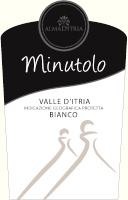
|
|
Minutolo Almaditria 2022 |
|
| Upal (Apulia, Italy) | |
 Minutolo Minutolo | |
| Price: € 14.00 | Score: |
 Brilliant straw yellow and nuances of straw yellow, very transparent. Brilliant straw yellow and nuances of straw yellow, very transparent. Intense, clean, pleasing, refined and elegant, starts with hints of
apple, peach and citron followed by aromas of hawthorn, broom, jasmine,
pear, melon, pineapple, mango, plum, honey and mineral. Intense, clean, pleasing, refined and elegant, starts with hints of
apple, peach and citron followed by aromas of hawthorn, broom, jasmine,
pear, melon, pineapple, mango, plum, honey and mineral.
 Crisp attack and however balanced by alcohol, good body, intense
flavors, agreeable. Crisp attack and however balanced by alcohol, good body, intense
flavors, agreeable.
 Persistent finish with flavors of apple, peach and citron. Persistent finish with flavors of apple, peach and citron. Aged in steel tanks. Aged in steel tanks. |
|
 Pasta with fish and crustaceans, Stewed fish with mushrooms, Sauteed white meat, Vegetable flans, Dairy products Pasta with fish and crustaceans, Stewed fish with mushrooms, Sauteed white meat, Vegetable flans, Dairy products |
|
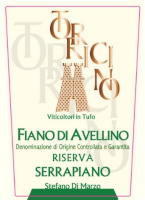
|
|
Fiano di Avellino Riserva Serrapiano 2021 |
|
| Torricino (Campania, Italy) | |
 Fiano Fiano | |
| Price: € 18.00 | Score: |
 Brilliant straw yellow and nuances of straw yellow, very transparent. Brilliant straw yellow and nuances of straw yellow, very transparent. Intense, clean, pleasing, refined and elegant, starts with hints of
apple, pear and pineapple followed by aromas of hawthorn, broom, jasmine,
peach, grapefruit, medlar, plum, hazelnut, linden and mineral. Intense, clean, pleasing, refined and elegant, starts with hints of
apple, pear and pineapple followed by aromas of hawthorn, broom, jasmine,
peach, grapefruit, medlar, plum, hazelnut, linden and mineral.
 Crisp attack and however balanced by alcohol, good body, intense
flavors, agreeable. Crisp attack and however balanced by alcohol, good body, intense
flavors, agreeable.
 Persistent finish with flavors of apple, pear and hazelnut. Persistent finish with flavors of apple, pear and hazelnut. 6 months in steel tanks. 6 months in steel tanks. |
|
 Pasta with fish and mushrooms, Stewed white meat, Stewed fish, Fish and mushroom soups Pasta with fish and mushrooms, Stewed white meat, Stewed fish, Fish and mushroom soups |
|
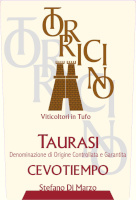
|
|
Taurasi Cevotiempo 2019 |
|
| Torricino (Campania, Italy) | |
 Aglianico Aglianico | |
| Price: € 25.00 | Score: |
 Intense ruby red and nuances of garnet red, little transparency. Intense ruby red and nuances of garnet red, little transparency. Intense, clean, pleasing, refined and elegant, starts with hints of
black cherry, plum and violet followed by aromas of carnation, dried rose,
blackberry, blueberry, carob, cocoa, tobacco, mace, leather, vanilla and
menthol. Intense, clean, pleasing, refined and elegant, starts with hints of
black cherry, plum and violet followed by aromas of carnation, dried rose,
blackberry, blueberry, carob, cocoa, tobacco, mace, leather, vanilla and
menthol.
 Properly tannic attack and however balanced by alcohol, full body,
intense flavors, pleasing crispness. Properly tannic attack and however balanced by alcohol, full body,
intense flavors, pleasing crispness.
 Persistent finish with flavors of black cherry, plum and blackberry. Persistent finish with flavors of black cherry, plum and blackberry. 24 months in cask, 12 months in bottle. 24 months in cask, 12 months in bottle. |
|
 Game, Roasted meat, Braised and stewed meat with mushrooms, Hard cheese Game, Roasted meat, Braised and stewed meat with mushrooms, Hard cheese |
|
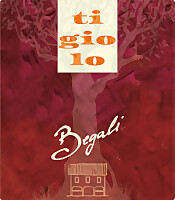
|
|
Tigiolo 2018 |
|
| Begali (Veneto, Italy) | |
 Corvina (40%), Cabernet Sauvignon (40%), Rondinella (10%), Merlot (10%) Corvina (40%), Cabernet Sauvignon (40%), Rondinella (10%), Merlot (10%) | |
| Price: € 16.00 | Score: |
 Intense ruby red and nuances of garnet red, little transparency. Intense ruby red and nuances of garnet red, little transparency. Intense, clean, pleasing, refined and elegant, starts with hints of
plum, black currant and black cherry followed by aromas of dried violet,
blueberry, blackberry, cocoa, tobacco, licorice, leather, mace, vanilla and
eucalyptus. Intense, clean, pleasing, refined and elegant, starts with hints of
plum, black currant and black cherry followed by aromas of dried violet,
blueberry, blackberry, cocoa, tobacco, licorice, leather, mace, vanilla and
eucalyptus.
 Properly tannic attack and however balanced by alcohol, full body,
intense flavors, pleasing roundness. Properly tannic attack and however balanced by alcohol, full body,
intense flavors, pleasing roundness.
 Persistent finish with flavors of plum, black currant and black cherry. Persistent finish with flavors of plum, black currant and black cherry. Aged in cask and barrique. Aged in cask and barrique. |
|
 Game, Roasted meat, Braised and stewed meat, Hard cheese Game, Roasted meat, Braised and stewed meat, Hard cheese |
|
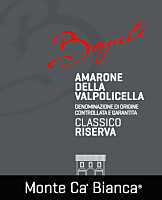
|
|
Amarone della Valpolicella Classico Riserva Monte Ca' Bianca 2017 |
|
| Begali (Veneto, Italy) | |
 Corvina (40%), Corvinone (35%), Rondinella (20%), Oseleta (5%) Corvina (40%), Corvinone (35%), Rondinella (20%), Oseleta (5%) | |
| Price: € 43.00 | Score: |
 Intense ruby red and nuances of garnet red, little transparency. Intense ruby red and nuances of garnet red, little transparency. Intense, clean, pleasing, refined and elegant, starts with hints of
blackberry, plum and dried violet followed by aromas of black cherry,
blueberry, tamarind, tobacco, chocolate, cinnamon, leather, licorice, mace,
vanilla and menthol. Intense, clean, pleasing, refined and elegant, starts with hints of
blackberry, plum and dried violet followed by aromas of black cherry,
blueberry, tamarind, tobacco, chocolate, cinnamon, leather, licorice, mace,
vanilla and menthol.
 Properly tannic attack and however balanced by alcohol, full body,
intense flavors, pleasing roundness. Properly tannic attack and however balanced by alcohol, full body,
intense flavors, pleasing roundness.
 Very persistent finish with long flavors of blackberry, plum and black
cherry. Very persistent finish with long flavors of blackberry, plum and black
cherry.
 40 months in barrique, 6 months in cask, at least 6 months in bottle. 40 months in barrique, 6 months in cask, at least 6 months in bottle. |
|
 Game, Roasted meat, Braised and stewed meat, Hard cheese Game, Roasted meat, Braised and stewed meat, Hard cheese |
|
News |
|
In this section are published news and information about events concerning the world of wine and food. Whoever is interested in publishing this kind of information can send us a mail to our address.
|
AquavitaeReview of Grappa, Distillates and Brandy |
|
|
||||||||||||
Wine Guide ParadeSeptember 2023
|
| |||||||
Privacy Policy | |||||||


| Copyright © 2002-2024 Antonello Biancalana, DiWineTaste - All rights reserved |
| All rights reserved under international copyright conventions. No part of this publication and of this WEB site may be
reproduced or utilized in any form or by any means, electronic or mechanical, without permission in writing from DiWineTaste. |